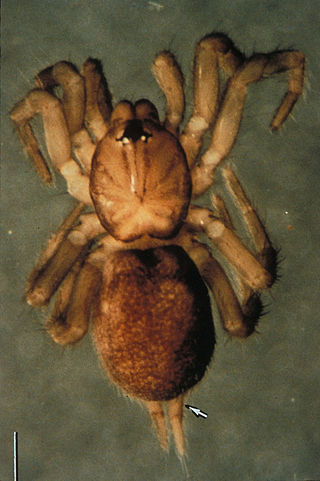
Microhexura is a genus of tiny North American spiders that was first described by C. R. Crosby & S. C. Bishop in 1925. It is the only genus in the family Microhexuridae. As of July 2020, it contained only two species, both found in the United States: M. idahoana and M. montivaga. M. montivaga occurs in the higher peaks of the Blue Ridge Mountains of North Carolina and Tennessee. M. idahoana occurs farther west, in the Cascades, the Blue Mountains, and the northern Rocky Mountains.

Cybaeidae is a family of spiders first described by Nathan Banks in 1892. The diving bell spider or water spider Argyroneta aquatica was previously included in this family, but is now in the family Dictynidae.
Ceratinella is a genus of dwarf spiders that was first described by James Henry Emerton in 1882. They are very similar to both Ceraticelus and Idionella, and the taxonomy of these spiders may change.
Scotinotylus is a genus of sheet weavers that was first described by Eugène Louis Simon in 1884.
Spirembolus is a genus of North American sheet weavers that was first described by Ralph Vary Chamberlin in 1920.

Ceraticelus is a genus of dwarf spiders that was first described by Eugène Louis Simon in 1884.
Ceraticelus innominabilis is a spider in the family Linyphiidae. It is found in Alaska.
Yorima is a genus of araneomorph spiders in the family Cybaeidae, and was first described by R. V. Chamberlin & Wilton Ivie in 1942. Originally placed in the funnel weaver family, it was moved to the Dictynidae in 1967, and to the Cybaeidae in 2017.
Cheniseo is a genus of North American dwarf spiders that was first described by S. C. Bishop & C. R. Crosby in 1935.
Disembolus is a genus of North American dwarf spiders that was first described by Ralph Vary Chamberlin & Vaine Wilton Ivie in 1933.
Floricomus is a genus of North American dwarf spiders that was first described by C. R. Crosby & S. C. Bishop in 1925.

Grammonota is a genus of dwarf spiders that was first described by James Henry Emerton in 1882.
Idionella is a genus of North American dwarf spiders that was first described by Nathan Banks in 1893.
Satilatlas is a genus of sheet weavers that was first described by Eugen von Keyserling in 1886.
Sciastes is a genus of sheet weavers that was first described by S. C. Bishop & C. R. Crosby in 1938.
Sisicottus is a genus of sheet weavers that was first described by S. C. Bishop & C. R. Crosby in 1938. They can be found in moss and litter of conifer forests.
Tachygyna is a genus of North American sheet weavers that was first described by Ralph Vary Chamberlin & Vaine Wilton Ivie in 1939.
Collinsia is a genus of dwarf spiders that was first described by Octavius Pickard-Cambridge in 1913.

Phrurotimpus is a genus of araneomorph spiders first described by R. V. Chamberlin and Wilton Ivie in 1935. The name is a compound adjective meaning "guarding the stone". Originally added to the Liocranidae, it was moved to the Corinnidae in 2002, then to the Phrurolithidae in 2014. They have red egg sacs that look like flattened discs, often found on the underside of stones.




